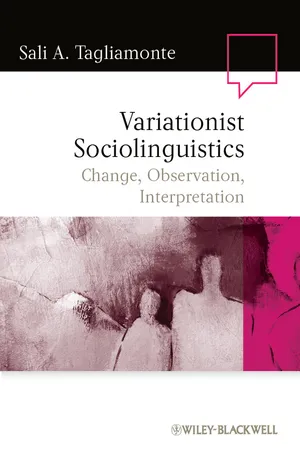Social Sciences
Changing Patterns
"Changing Patterns" refers to the shifts and transformations observed in various aspects of society over time. These changes can encompass a wide range of phenomena, including demographic shifts, cultural trends, economic patterns, and social behaviors. Studying changing patterns allows for a deeper understanding of the dynamics and evolution of societies, and can provide valuable insights for addressing contemporary social issues.
Written by Perlego with AI-assistance
Related key terms
1 of 5
3 Key excerpts on "Changing Patterns"
- eBook - ePub
Variationist Sociolinguistics
Change, Observation, Interpretation
- Sali A. Tagliamonte(Author)
- 2011(Publication Date)
- Wiley-Blackwell(Publisher)
The changing temper of the period in which we live is reflected in a changing language. (McKnight 1925: 16)SummaryPatterns in language data can implicate language external influences or language internal processes or both. The frequency of linguistic variants examined accountably with careful circumscription of the variable context and arrayed according to the age of the individual can reveal much about the nature of the linguistic variable. Is the pattern of distribution of a feature flat, sloping, peaking, or otherwise? This will inform the interpretation of language usage in the community. What type of linguistic change is in evidence? The patterns provide an important clue. The study of linguistic change in progress has repeatedly demonstrated that several key characteristics of the social context are crucial to understanding language change. Three features pointing to the social nature of linguistic change are the following (from Labov 2001a: 75): (1) the unpredictability of change, (2) the unrestricted directionality of change, and (3) the existence of stable variation.The classic sociolinguistic patterns are based on independent variables which were defined according to major sociological categories such as class, education, style, and sex. When sociolinguistic surveys are based on large-scale samples such as the city studies of the 1960s and 1970s, speakers were categorized based on these gross social categories. There are, of course, innumerable (if not infinite) ways of delineating groups in society. Other correlates that have also been considered include ethnicity, race, mobility, network, register, interactional context, attribute of the interlocutor, and group affiliation, among many others. At the same time it has become increasingly obvious that speakers utilize the variation within their linguistic repertoires to accomplish plenty of other social meanings (e.g. Eckert 2000). All of these external, socially defined, characteristics may influence the choices people make when speaking or writing. - eBook - ePub
- Mehran Kamrava(Author)
- 2012(Publication Date)
- Routledge(Publisher)
Changes in social conduct and cultural outlook on the one hand, and in industrial and economic infrastructures of society on the other, often develop simultaneously and as a consequence of one another, frequently reinforcing each other. There has long been an intense academic debate over the primacy and greater political relevance of social and cultural changes as opposed to industrial and economic ones. Ultimately, the significance attributed to one approach over another often depends on the doctrinal lenses through which the subject is studied. However, particularly in so far as the study of political and sociological characteristics is concerned, minimising the importance of either socio-cultural or industrial–economic developments, whether independently or at the expense of one another, is at best academically short-sighted. Social change is fostered by complex and interrelated dynamics that arise out of both industrial and economic forces as well as social and cultural factors. Within this framework, an examination of processes and ramifications of social change in the developing world assumes great importance.Simply put, social change refers to the ‘alteration of a social system over time’.1 It entails changes in the social and cultural underpinnings of a society.2 More specifically, social change results in changes in attitudes, views and the social and cultural outlooks of those whom it affects. As I have noted elsewhere, ‘one of the effects of social change is the lack of persistence of norms (i.e. the expected pattern of behaviour)’.There are many conflicting varieties of accepted, or rather competing, modes of social behaviour in a society undergoing social change and it becomes impossible to detect a single and identifiably consistent set of norms. There is, therefore, conflict not only between the differing social values that prevail in society but also between norms. Rural immigrants, industrial labourers, wage-earners, the salaried middle class, and even the wealthy elite are all confronted with the enigmatic problem of how to behave properly in the presence of others with equal or superior social standing. The accepted and expected patterns of conduct and behaviour undergo such rapid changes, and new social groupings and segments develop at such rapid rates that the society as a whole cannot retain an interrelated set of norms. Each social group acquires its own set of norms, along with its attached values, and thus there often develops a vast gap between the value system of one group as opposed to those of another.3 - eBook - ePub
Sociology (Routledge Revivals)
A guide to problems and literature
- Tom B. Bottomore(Author)
- 2010(Publication Date)
- Taylor & Francis(Publisher)
The questions concerning the manner, direction and rate of change require for their answer historical description and interpretation, such as have been provided, for example, in the various accounts of population changes, of the increasing division of labour in industrial societies, of the changes in the character of the modern Western family, and so on. Discussion of the direction of change need not involve any value judgments; the diminishing size of the family, and the increasing size of economic units, are matters of historical fact. But in other cases, the direction of change may be less obvious and may become the subject of divergent interpretations. Moreover, the change itself may be one which is difficult to observe in a detached way, e.g. the increase in the divorce rate, or the extension of ‘bureaucracy’; and discussions of the direction of change are then likely to become closely involved with moral evaluations. Finally, when it is a matter of analyzing changes in the total structure of a society, whether it be a historical or present day society, the line of demarcation between the critical analysis and the expression of a social philosophy becomes obscure and uncertain, and can perhaps never be rigorously established. This is apparent if we consider the widely divergent accounts of the changes taking place in the British Welfare State, or in the USSR since the death of Stalin, or in India since the attainment of independence; or, on a larger scale, the contradictory accounts proffered by Marx and Max Weber of the dominant trends of change in capitalist societies.The rate of change has always interested sociologists, and it is a commonplace to refer to the acceleration of social and cultural change in modern times. W.F.Ogburn was one of the first to examine the phenomenon systematically and to undertake quantitative studies of the rate of exchange, especially in the sphere of technological inventions.1 He also focussed attention upon the discrepancies between rates of change in different sectors of social life; the hypothesis of ‘cultural lag’ is concerned with a major disharmony between the rapid growth of technology, and the slower transformation of familial, political and other institutions and of traditional beliefs and attitudes (religious, moral etc.). In recent years these problems have acquired greater importance, with the emergence of industrialization of underdeveloped countries as a major issue in world politics.2 Research has followed two principal lines; sociological studies of the changes in social structure and culture induced by industrialization and the structural disharmonies of the transition period, and psychological studies of the adaptation of individuals to rapid social changes.3 Some of these problems as they appear in India will be discussed in the following sections.1 Social Change (op. cit.), Part II. See also W.F.Ogburn and M.F.Nimkoff, A Handbook of Sociology,
Index pages curate the most relevant extracts from our library of academic textbooks. They’ve been created using an in-house natural language model (NLM), each adding context and meaning to key research topics.


